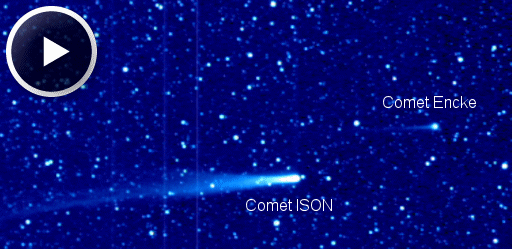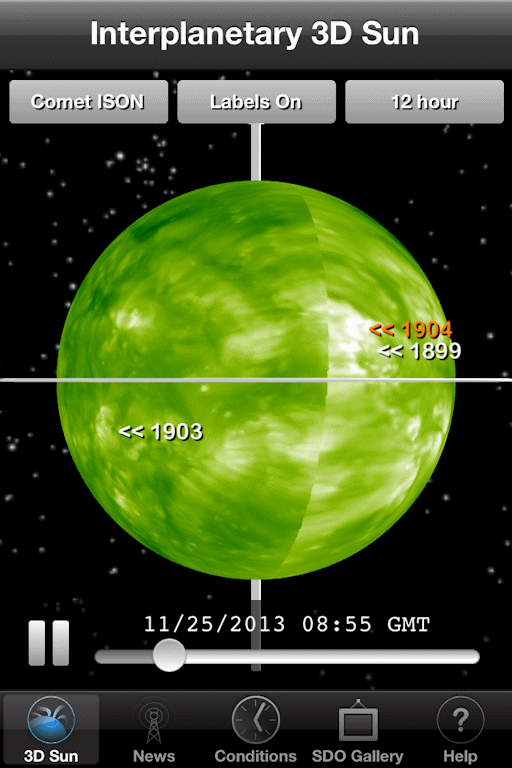NIGHT-SHINING CLOUDS REAPPEAR OVER ANTARCTICA: The southern season for noctilucent clouds (NLCs) is underway. NASA's AIM spacecraft detected the first wispy tendrils of NLCs over Antarctica on Nov. 21st and since then the electric-blue clouds have spread and brightened. Scroll down the page and look left for latest images.
IS COMET ISON IN TROUBLE? Astronomers using the IRAM millimeter telescope in Spain are reporting a sharp change in Comet ISON. "We observe consistent, rapid fading of the molecular emission lines between Nov. 21 and Nov. 25 by at least a factor of 20. This may indicate that the nucleus is now at best marginally active or that... it no longer exists," says Michal Drahus of Caltech.
It's too soon to panic, though. First, click on the image to watch a new movie from NASA's STEREO-A spacecraft (31 MB), then scroll down for continued discussion:

Credits: This movie was made by reader Rob Matson using data from STEREO-A.
The movie spans a 3+ day interval from Nov. 21 (00:09 UT) to Nov. 24 (08:09 UT), which overlaps the period when IRAM recorded the fading emission lines. Although "puffs" of material can be seen billowing down the comet's tail, the comet itself still appears to be intact.
Astronomer Karl Battams of NASA's Comet ISON Observing Campaign comments: "[The fading emission lines] could indicate that the nucleus has completely disrupted, releasing an enormous volume of dust while significantly reducing emission rates. Fragmentation or disruption of the nucleus has always been the highest risk factor for this comet so if this has indeed happened then while unfortunate, it would not be a surprise."
"However," he continues, "these reports are new, and while they are undoubtedly valid, we do still need to keep observing the comet to be sure what it happening. Remember: Comet ISON is a dynamically new sungrazing comet, fresh in from the Oort Cloud, and the last time we saw an object like this was never! Furthermore, a sungrazing comet just three days from perihelion has never been studied in this kind of detail - we're breaking new ground! When we factor in your standard 'comets are unpredictable' disclaimer, what we have is a huge recipe for the unknown."
Stay tuned for updates.
Realtime Comet ISON Photo Gallery
WHICH SIDE OF THE SUN IS FACING COMET ISON? When Comet ISON sweeps through the sun's atmosphere on Nov. 28th, it will be in the 'hot zone' for CMEs. A strike by one of the massive storm clouds probably wouldn't destroy the comet, but it could have a dramatic effect on the comet's fragile tail. The odds of a strike depend on which side of the sun is facing the comet at the time of the flyby. This is something you can monitor using a NASA iPhone app called the Interplanetary 3D Sun:
The app displays an interactive 3D model of the entire sun photographed by extreme UV cameras onboard NASA's twin STEREO probes. The data are realtime and fully interactive (pinch, spin and zoom). As shown in this target list, you can view the sun from many locations around the solar system--including Comet ISON.
Active regions are color-coded by their potential for flares: Orange means "expect M-class solar flares," while red denotes sunspots capable of X-flares. In the screen shot above we see that Comet ISON is bearing down on an active region, AR1904, that poses a threat for M-class eruptions. A CME might be in the offing after all. Solar flare alerts: text, voice

Solar wind
speed: 312.4 km/sec
density: 2.5 protons/cm3
explanation | more data
Updated: Today at 1927 UT
X-ray Solar Flares
6-hr max: B8 1332 UT Nov26
24-hr: C1 0129 UT Nov26
explanation | more data
Updated: Today at: 1900 UT
![]()
Daily Sun: 26 Nov 13
Sunspots AR1904 and AR1905 have 'beta-gamma' magnetic fields that harbor energy for M-class solar flares. Neither sunspot, however, is facing Earth nor actively flaring. Credit: SDO/HMI
![]()
Sunspot number: 52
What is the sunspot number?
Updated 26 Nov 2013
Spotless Days
Current Stretch: 0 days
2013 total: 0 days (0%)
2012 total: 0 days (0%)
2011 total: 2 days (<1%)
2010 total: 51 days (14%)
2009 total: 260 days (71%)
Since 2004: 821 days
Typical Solar Min: 486 days
Update 26 Nov 2013
The Radio Sun
10.7 cm flux: 119 sfu
explanation | more data
Updated 26 Nov 2013
![]()
Current Auroral Oval:
Switch to: Europe, USA, New Zealand, Antarctica
Credit: NOAA/POES
![]()
Planetary K-index
Now: Kp= 1 quiet
24-hr max: Kp= 1 quiet
explanation | more data
Interplanetary Mag. Field
Btotal: 4.1 nT
Bz: 3.2 nT south
explanation | more data
Updated: Today at 1927 UT
![]()
Coronal Holes: 26 Nov 13
There are no large coronal holes on the Earthside of the sun. Credit: SDO/AIA.





